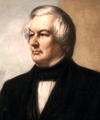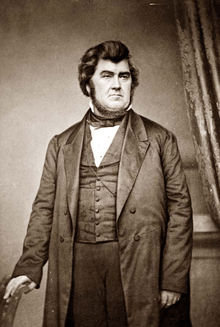1856 American National Convention
The 1856 American National Convention was held in National Hall in Philadelphia, Pennsylvania, on February 22 to 25, 1856. The American Party, formerly the Native American Party, was the vehicle of the Know Nothing movement. The American Party absorbed most of the former Whig Party in 1854, and by 1855 it had established itself as the chief opposition party to the Democrats. In the 82 races for the House of Representatives in 1854, the American Party ran 76 candidates, 35 of whom won. None of the six Independents or Whigs who ran in these races was elected. The party then succeeded in electing Nathaniel P. Banks as Speaker of the House in the 34th Congress.
| 1856 presidential election | |
.png) .jpg) Nominees Fillmore and Donelson | |
| Convention | |
|---|---|
| Date(s) | February 22–25, 1860 |
| City | Philadelphia, Pennsylvania |
| Candidates | |
| Presidential nominee | Millard Fillmore of New York |
| Vice presidential nominee | Andrew Jackson Donelson of Tennessee |
Following the decision by party leaders in 1855 not to press the slavery issue, the convention had to decide how to deal with the Ohio chapter of the party, which was vocally anti-slavery. The convention closed the Ohio chapter and re-opened it under more moderate leadership. Delegates from Ohio, Pennsylvania, Illinois, Iowa, New England, and other Northern states bolted when a resolution declaring that no candidate that was not in favor of prohibiting slavery north of the 36'30' parallel would be granted the nomination was voted down.[1] This removed a greater part of the American Party's support in the North outside of New York, where the conservative faction of the Whig Party remained faithful.[2] Former President Millard Fillmore was nominated for president with 179 votes out of the 234 votes cast. The convention chose Andrew Jackson Donelson of Tennessee for vice president with 181 votes to 30 scattered votes and 24 abstentions.
Candidates gallery
| Presidential Ballots | Informal 1 | Formal 2 | Vice Presidential Ballot | |
|---|---|---|---|---|
| Millard Fillmore | 139 | 179 | Andrew J. Donelson | 181 |
| George Law | 27 | 35 | Scattering | 18 |
| Garrett Davis | 18 | 8 | Henry J. Gardiner | 12 |
| Kenneth Rayner | 14 | 2 | ||
| John McLean | 13 | 1 | ||
| Robert F. Stockton | 8 | 2 | ||
| Sam Houston | 6 | 4 | ||
| John Bell | 5 | 2 | ||
| Erastus Brooks | 2 | 1 | ||
| Lewis D. Campbell | 1 | 0 | ||
| John Middleton Clayton | 1 | 0 |
North American Seceders Party nomination

Former Commodore and Military Governor Robert F. Stockton of New Jersey
(Withdrew - Endorsed Fillmore)
A group of North American delegates called the North American Seceders withdrew from the convention and met separately. They objected to the attempt to work with the Republican Party. The Seceders held their own national convention on 6/16-17/1856. 19 delegates unanimously nominated Robert F. Stockton for president and Kenneth Raynor for vice-president. The Seceders' ticket later withdrew from the contest, with Stockton endorsing Millard Fillmore for the Presidency.[3]
References
- Arthur M. Schlesinger Jr. American Presidential Elections. p. 1020.
- Eugene H. Roseboom. A History of Presidential Elections. p. 159.
- Eugene H. Roseboom. A History of Presidential Elections. p. 160.

